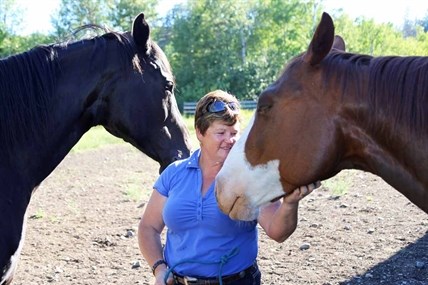
Shelley Ogilvie with two of her six horses. She has been around horses her entire life and by becoming a farrier made them her career as well.
(JENNIFER STAHN / iNFOnews.ca)
July 09, 2014 - 4:39 PM
THOMPSON-OKANAGAN - During the horse and buggy age, farriers were as common as mechanics ensuring travellers had four on the floor to get from point A to point B but today, they're an elusive service provider.
Anyone with a horse likely uses the service of someone specializing in horse feet. One local farrier says while there are only a handful listed in phonebooks, they represent maybe a quarter of how many farriers are actually working in the region.
“I’m as busy as I ever want,” Shelley Ogilvie says. She is not able to take on any more clients. “Right now we’re stuck because people are calling left, right and centre to get their horses done and I have no one to refer them to because we’re in a bit of a crunch. One farrier went to work in a mine, another is in school and another got hurt.”
While it appears there is a shortfall of farriers in the area, Ogilvie, who has been around horses her entire life and in the business for 30 years, believes there are a lot more farriers today than there was even 10 years ago.
“Farriers are becoming far more numerous because a lot of agriculture properties are being bought up by small property owners who are only interested in horses and not in farming,” she says. “There’s a strong trend towards this.”
Ogilvie first went to school to become a farrier in 1984 and says since then there’s a lot more female farriers as well.
“Girls tend to be much more involved in horses,” she notes. “I’m pretty sure they must graduate at half and half at Kwantlen (Polytechnic University.)”
While there are a lot of people graduating through these types of programs Ogilvie says there is not nearly as many who stay in the business. She stresses it is not only a physical job but you also need to have a good mind for business and a lot of motivation to be self-employed.
“It’s not the type of job many people can do. You have to be motivated too. When you’re tired and sore you still go to work and finish, and you’re dealing with cranky horses and cranky owners,” she says, “And it’s hugely physical, you’re often carrying 1,200 pounds of horse sitting on you. It’s very, very hard work. I love it as a job.”
Ogilvie says there is no typical day, it changes by horse and season but she can always count on this time of year (which) tends to be the busiest. She can do 16 trims in a day but chooses to not do more than four or five horses for shoeing. The number of horses she can see in a day also varies by how much driving is required between ranches.
The grandmother says she chooses to work only with horses she sees regularly and as a result is not often exposed to many severe hoof-related problems, though she has seen a case where white line disease got so out of hand the hoof completely separated from the foot. White line disease is progressive, occurring when the area between the hoof wall and sole becomes damaged, allowing fungus to enter. The resulting infection eats away at the hoof wall gradually separating it from the sole.
Farrier tools used are still pretty simple but Ogilvie says the science behind it has evolved.
“It’s a lot of the same tools. There’s a huge amount of science that goes into it yet it’s still very similar to the old days,” she notes. “A lot of it is having a good eye. We’re still making the horses so they’re comfortable.
Ogilvie on what people don’t understand about her job:
- It’s not always nice to work outside. It sucks to work in the extreme hot and cold weather, as well as in strong winds, with crabby horses and with crabby people.
- Farming is more work that you would ever think that it is.
- There’s a lot of skill, art and finesse needed, not brute force.
- You need to know anatomy and styles of horse feet, every horse is different.
- Horseshoes are needed when the feet wear off faster than they grow or could easily get damaged, usually on horses that are ridden a lot or used as work horses.
- Hooves grow quickest in spring when the ground is soft.
- There are three main steps to trimming hooves — cleaning, nipping (trimming) and dressing (filing.)
- Flies are one of the biggest dangers to a farrier. “The quietest horse can hurt you when they’re kicking at flies.”
To contact a reporter for this story, email Jennifer Stahn at jstahn@infonews.ca or call 250-819-3723. To contact an editor, email mjones@infonews.ca or call 250-718-2724.
News from © iNFOnews, 2014